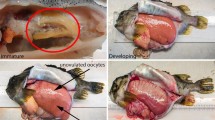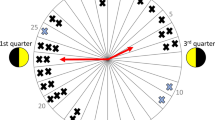Synopsis
We describe the short-term patterns of egg production and release in the lemon tetra, Hyphessobrycon pulchripinnis (Characidae) as observed over a six month aquarium study and then use our results and those of others to both describe general patterns and derive comparative predictions. Female lemon tetras ovulated about once every four days; differences among individuals were small and inconsistent. As in other species, the probability of ovulation depended strongly on time since last ovulation, indicative of an ovarian cycle; furthermore we found no obvious long-term patterns of ovulation within females and batch fecundity was independent of the length of the two previous interovulation intervals and of the one following. Each batch of ovulated eggs was released over an average of 23.1 spawning acts, beginning as soon as the lights went on in the morning. The number of spawning acts increased with ovulation fecundity but decreased with the number of other females spawning in the tank on that day. The mass of eggs produced every four days was greater than that of the remaining ovary, and the mass of eggs that could be produced in a season was greater than that of the female. This latter observation highlights the most important consequence of repeated reproduction within a season - increased reproductive output - and leads to predictions associating it with less seasonal environments (e.g. low latitudes), as well as with small ovaries and small body size. The significance of releasing a batch of eggs over many spawning acts remains unknown.
Similar content being viewed by others
References cited
Bagenal, T.B. 1978. Aspects of fish fecundity. pp. 75–101. In: S.D. Gerking (ed.) Ecology of Freshwater Fish Production, Blackwell Scientific Publications, Oxford.
Bauer, J.A. Jr. & S.E. Bauer. 1981. Reproductive biology of pigmy angelfishes of the genus Centropyge (Pomacanthidae). Bull. Mar. Sci. 31: 495–513.
Bell, G. 1976. On breeding more than once. Amer. Nat. 110: 57–77.
Blueweiss, L., H. Fox, V. Kudzma, D. Nakashima, R. Peters & S. Sams. 1978. Relationships between body size and some life history parameters. Oecologia 37: 257–272.
Cunningham, J.E.R. & E.K. Balon. 1985. Early ontogeny of Adinia xenica (Pisces, Cyprinodontiformes): 1. The development of embryos in hiding. Env. Biol. Fish. 14: 115–166.
Cunningham, J.E.R. & E.K. Balon. 1986. Early ontogeny of Adinia xenica (Pisces, Cyprinodontiformes): 3. Comparison and evolutionary significance of some patterns in epigenesis of egg-scattering, hiding and bearing cyprinodontiforms. Env. Biol. Fish. 15: 91–105.
DeMartini, E.E. & R.K. Fountain. 1981. Ovarian cycling frequency and batch fecundity in the queenfish, Seriphus politus: attributes representative of serial spawning fishes. U.S. Fish. Bull. 79: 547–560.
DeVlaming, V. 1983. Oocyte development patterns and hormonal involvements among teleosts. pp. 176–199. In: J.C. Rankin, T.J. Pitcher & R.T. Duggan (ed.) Control Processes in Fish Physiology, John Wiley, New York.
Eaton, R.C. & R.D. Farley. 1974. Spawning cycle and egg production of zebrafish, Brachydanio rerio, in the laboratory. Copeia 1974: 195–204.
Gale, W.F. 1983. Fecundity and spawning frequency of caged bluntnose minnows-fractional spawners. Trans. Amer. Fish. Soc. 112: 398–402.
Gale, W.F. & G.L. Buynak. 1978. Spawning frequency and fecundity of satinfin shiner (Notropis analostanus) — a fractional, crevice spawner. Trans. Amer. Fish. Soc. 107: 460–463.
Gale, W.F. & G.L. Buynak. 1982. Fecundity and spawning frequency of the fathead minnow — a fractional spawner. Trans. Amer. Fish. Soc. 111: 35–40.
Gale, W.F. & W.G. Deutsch. 1985. Fecundity and spawning frequency of captive tessellated darters-fractional spawners. Trans. Amer. Fish. Soc. 114: 220–229.
Gale, W.F. & C.A. Gale. 1977. Spawning habits of spotfin shiner (Notropis spilopterus) — a fractional, crevice spawner. Trans. Amer. Fish. Soc. 106: 170–177.
Géry, J. 1980. Rediscovery of the lemon tetra Hyphessobrycon pulchripinnis. Trop. Fish Hobbyist 28: 35–40.
Hirshfield, M.F. 1980. An experimental analysis of reproductive effort and cost in the Japanese medaka, Oryzias latipes. Ecology 61: 282–292.
Hubbs, C. 1976. The diel reproductive pattern and fecundity of Menidia audens. Copeia 1976: 386–388.
Hubbs, C. 1985. Darter reproductive seasons. Copeia 1985: 56–68.
Hunter, J.R. & S.R. Goldberg. 1980. Spawning incidence and batch fecundity in northern anchovy, Engraulis mordax. U.S. Fish. Bull. 77: 641–652.
Hunter, J.R. & B.J. Macewicz. 1980. Sexual maturity, batch fecundity, spawning frequency, and temporal pattern of spawning for the northern anchovy, Engraulis mordax, during the 1979 spawning season. Calif. Coop. Oceanic Fish. Invest. Rep. 21: 139–149.
Kirkendall, L.R. & N.C. Stenseth. 1985. On defining ‘breeding once’. Amer. Nat. 125: 189–204.
Kramer, D.L. 1978. Reproductive seasonality in the fishes of a tropical stream. Ecology 59: 976–985.
Lindsey, C.C. 1966. Body sizes of poikilotherm vertebrates at different latitudes. Evolution 20: 456–465.
Lotrich, V.A. & W.H. Meredith. 1974. A technique and the effectiveness of various acrylic colors for subcutaneous marking of fish. Trans. Amer. Fish. Soc. 103: 140–142.
Mackay, I. & K.H. Mann. 1969. Fecundity of two cyprinid fishes in the River Thames, Reading, England. J. Fish. Res. Board Can. 26: 2795–2805.
Nagel, R. 1986. Untersuchungen zur Eiproduktion beim Zebrabärbling (Brachydanio rerio, Ham.-Buch.) J. Appl. Ichthyol. 4: 173–181.
Nakatsuru, K. & D.L. Kramer. 1982. Is sperm cheap? Limited male fertility and female choice in the lemon tetra (Pisces, Characidae). Science 216: 753–755.
Niimi, A.J. & Q.N. LaHam. 1974. Influence of breeding time interval on egg number, mortality, and hatching of the zebra fish Brachydanio rerio. Can. J. Zool. 52: 515–517.
Nikolsky, G.V. 1970. On some zonal features in the process of fish production in waterbodies of different latitudes. Ber. Dtsch. Wiss. Komm. Meeresforsch. 21: 27–32.
Peters, R.H. 1983. The ecological implications of body size. Cambridge University Press, Cambridge. 329 pp.
Potts, G.W. & R.J. Wootton (ed.) 1984. Fish reproduction: strategies and tactics. Academic Press, London. 410 pp.
Qasim, S.Z. 1955. Time and duration of the spawning season in some marine teleosts in relation to their distribution. J. Conseil Intern. 21: 144–155.
Sokal, R.R. & F.J. Rohlf. 1981. Biometry, 2nd ed. W.H. Freeman, New York. 859 pp.
Taylor, P.D. & G.C. Williams. 1983. A geometric model for optimal life history. pp. 91–97. In: H.I. Freedman & C. Strobeck (ed.) Population Biology, Lect. Notes Biomath. #52, Springer-Verlag, Berlin.
Taylor, P.D. & G.C. Williams. 1984. Demographic parameters at evolutionary equilibrium. Can. J. Zool. 62: 2264–2271.
Wallace, R.A. & K. Selman. 1981. The reproductive activity of Fundulus heteroclitus females from Woods Hole, Massachusetts, as compared with more southerly locations. Copeia 1981: 212–215.
Williams, G.C. 1975. Sex and evolution. Princeton University Press, Princeton. 200 pp.
Wootton, R.J. 1973a. Fecundity of the three-spined stickleback, Gasterosteus aculeatus (L.) J. Fish Biol. 5: 683–688.
Wootton, R.J. 1973b. The effect of size of food ration on egg production in the female three-spined stickleback, Gasterosteus aculeatus L. J. Fish Biol. 5: 89–96.
Wootton, R.J. 1974. The inter-spawning interval of the female three-spined stickleback, Gasterosteus aculeatus. J. Zool. (Lond.) 172: 331–342.
Wootton, R.J. 1977. Effect of food limitation during the breeding season on the size, body components and egg production of female sticklebacks (Gasterosteus aculeatus). J. Anim. Ecol. 46: 823–834.
Wootton, R.J. 1979. Energy costs of egg production and environmental determinants of fecundity in teleost fishes. pp. 133–159. In: P.J. Miller (ed.) Fish Phenology: Anabolic Adaptiveness in Teleosts, Symp. Zool. Soc. Lond. No. 44.
Wootton, R.J. & G.W. Evans. 1976. Cost of egg production in the three-spined stickleback (Gasterosteus aculeatus L.). J. Fish Biol. 8: 385–395.
Author information
Authors and Affiliations
Rights and permissions
About this article
Cite this article
Burt, A., Kramer, D.L., Nakatsuru, K. et al. The tempo of reproduction in Hyphessobrycon pulchripinnis(Characidae), with a discussion on the biology of ‘multiple spawning’ in fishes. Environ Biol Fish 22, 15–27 (1988). https://doi.org/10.1007/BF00000541
Received:
Accepted:
Issue Date:
DOI: https://doi.org/10.1007/BF00000541




